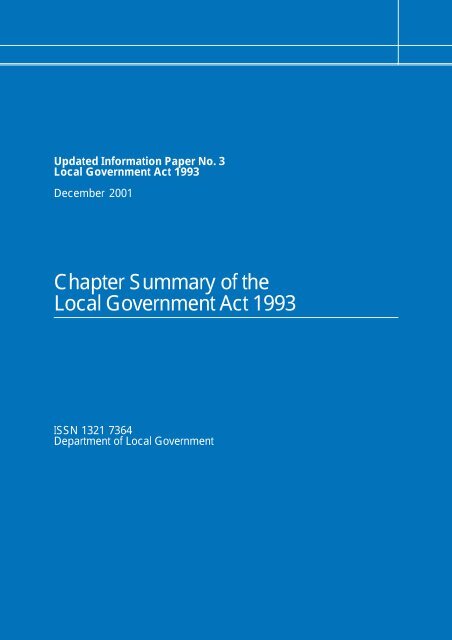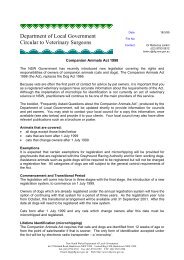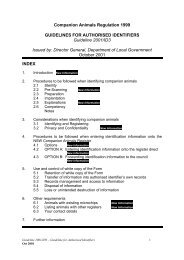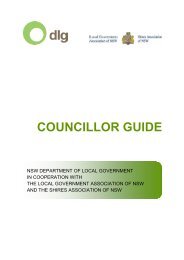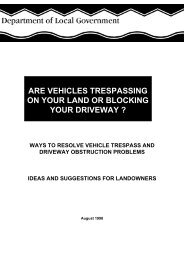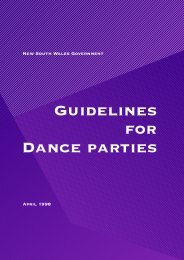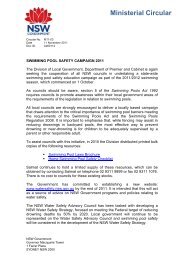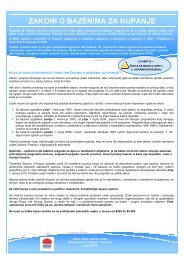Chapter Summary of the Local Government Act 1993 - Updated ...
Chapter Summary of the Local Government Act 1993 - Updated ...
Chapter Summary of the Local Government Act 1993 - Updated ...
Create successful ePaper yourself
Turn your PDF publications into a flip-book with our unique Google optimized e-Paper software.
<strong>Updated</strong> Information Paper No. 3<strong>Local</strong> <strong>Government</strong> <strong>Act</strong> <strong>1993</strong>December 2001<strong>Chapter</strong> <strong>Summary</strong> <strong>of</strong> <strong>the</strong><strong>Local</strong> <strong>Government</strong> <strong>Act</strong> <strong>1993</strong>ISSN 1321 7364Department <strong>of</strong> <strong>Local</strong> <strong>Government</strong>
Department <strong>of</strong> <strong>Local</strong> <strong>Government</strong>Access to ServicesDepartment <strong>of</strong> <strong>Local</strong> <strong>Government</strong> is located atCivic Tower BuildingLevels 10–1166–72 Rickard RdBankstown NSW 2200Postal AddressLocked Bag 1500Bankstown NSW 2200Telephone (02) 9793 0793Facsimile (02) 9793 0799Tty (02) 9707 2508email dlg@dlg.nsw.gov.auWebsite http://www.dlg.nsw.gov.auOffice HoursMonday to Friday 8.30am to 5.00pm(Special arrangements may be made if <strong>the</strong>se hours are unsuitable)All <strong>of</strong>fices are wheelchair accessibleAlternative Media PublicationsSpecial arrangements can be made for our publications to be provided inlarge print or in an alternative media format. If you require this service pleasecontact <strong>the</strong> publications section on (02) 9793 0711.DisclaimerAll due care has been taken in preparing and checking this informationdocument. The Department <strong>of</strong> <strong>Local</strong> <strong>Government</strong> emphasises that <strong>the</strong>document is <strong>the</strong> Department’s view only and should not be relied upon in anyrelevant legal proceedings. A council or o<strong>the</strong>r parties should be guided by<strong>the</strong>ir own legal advice.
<strong>Chapter</strong> <strong>Summary</strong> <strong>of</strong> <strong>the</strong> <strong>Local</strong> <strong>Government</strong> <strong>Act</strong> <strong>1993</strong>DISCLAIMER: ALL DUE CARE HAS BEEN TAKEN IN PREPARING AND CHECKING THIS INFORMATION DOCUMENT. THE DEPARTMENT OF LOCAL GOVERNMENT EMPHASISESTHAT THE DOCUMENT IS THE DEPARTMENT’S VIEW ONLY AND SHOULD NOT BE RELIED UPON IN ANY RELEVANT LEGAL PROCEEDINGS. A COUNCIL OR OTHER PARTIESSHOULD BE GUIDED BY THEIR OWN LEGAL ADVICE.1Contents<strong>Chapter</strong> <strong>Summary</strong> <strong>of</strong> <strong>the</strong> <strong>Local</strong> <strong>Government</strong> <strong>Act</strong> <strong>1993</strong><strong>Chapter</strong> 1. Preliminary ......................................................................... 2<strong>Chapter</strong> 2. What are <strong>the</strong> purposes <strong>of</strong> this <strong>Act</strong>? ................................... 2<strong>Chapter</strong> 3. What is a council’s charter? ............................................... 2<strong>Chapter</strong> 4. How can <strong>the</strong> communityinfluence what a council does? ............................................................ 2<strong>Chapter</strong> 5. What are a council’s functions? ......................................... 3<strong>Chapter</strong> 6. What are <strong>the</strong> service functions <strong>of</strong> councils? ...................... 3<strong>Chapter</strong> 7. What are <strong>the</strong> regulatory functions <strong>of</strong> councils? .................. 4<strong>Chapter</strong> 8. What ancillary functions does a council have? .................. 4<strong>Chapter</strong> 9. How are councils established? .......................................... 5<strong>Chapter</strong> 10. How are people elected to civic <strong>of</strong>fice? .......................... 5<strong>Chapter</strong> 11. How are councils staffed? ................................................ 6<strong>Chapter</strong> 12. How do councils operate? ............................................... 6<strong>Chapter</strong> 13. How are councils made accountablefor <strong>the</strong>ir actions? ................................................................................... 6<strong>Chapter</strong> 14. Honesty and disclosure <strong>of</strong> interests ................................. 7<strong>Chapter</strong> 15. How are councils financed? ............................................. 7<strong>Chapter</strong> 16. Offences ........................................................................... 8<strong>Chapter</strong> 17. Enforcement ..................................................................... 9<strong>Chapter</strong> 18. Miscellaneous ................................................................ 10
2 UPDATED INFORMATION PAPER NO. 3DISCLAIMER: ALL DUE CARE HAS BEEN TAKEN IN PREPARING AND CHECKING THIS INFORMATION DOCUMENT. THE DEPARTMENT OF LOCAL GOVERNMENT EMPHASISESTHAT THE DOCUMENT IS THE DEPARTMENT’S VIEW ONLY AND SHOULD NOT BE RELIED UPON IN ANY RELEVANT LEGAL PROCEEDINGS. A COUNCIL OR OTHER PARTIESSHOULD BE GUIDED BY THEIR OWN LEGAL ADVICE.<strong>Chapter</strong> 1. PreliminaryThis chapter contains provisions which are helpful in understanding<strong>the</strong> <strong>Act</strong> as a whole, as well as some machinery provisions.<strong>Chapter</strong> 2. What are <strong>the</strong>purposes <strong>of</strong> this <strong>Act</strong>?This chapter states <strong>the</strong> Parliament’s purposes in enacting this <strong>Act</strong>.Section 51 <strong>of</strong> <strong>the</strong> Constitution <strong>Act</strong> 1902 provides:(1) There shall continue to be a system <strong>of</strong> local government for <strong>the</strong> Stateunder which duly elected or duly appointed local government bodiesare constituted with responsibilities for acting for <strong>the</strong> bettergovernment <strong>of</strong> those parts <strong>of</strong> <strong>the</strong> State that are from time to timesubject to that system <strong>of</strong> local government.(2) The manner in which local government bodies are constituted and <strong>the</strong>nature and extent <strong>of</strong> <strong>the</strong>ir powers, authorities, duties and functions shallbe as determined by or in accordance with laws <strong>of</strong> <strong>the</strong> Legislature.(3) The reference in subsection (2) to laws <strong>of</strong> <strong>the</strong> Legislature shall be readas a reference to laws that have been enacted by <strong>the</strong> Legislature,whe<strong>the</strong>r before or after <strong>the</strong> commencement <strong>of</strong> this section, and thatare for <strong>the</strong> time being in force.(4) For <strong>the</strong> purposes <strong>of</strong> this section, <strong>the</strong> Western Lands Commissioner,<strong>the</strong> Lord Howe Island Board, and an administrator with all or any <strong>of</strong><strong>the</strong> functions <strong>of</strong> a local government body, shall be deemed to be localgovernment bodies.The chapter also aims to give an overview <strong>of</strong> <strong>the</strong> major elements in<strong>the</strong> system <strong>of</strong> local government in this State. It contains a diagramshowing <strong>the</strong> way in which <strong>the</strong>se elements relate to one ano<strong>the</strong>r.<strong>Chapter</strong> 3. What isa council’s charter?The charter contained in this chapter comprises a set <strong>of</strong> principles thatare to guide a council in <strong>the</strong> carrying out <strong>of</strong> its functions. A councilmay add o<strong>the</strong>r principles not inconsistent with those in <strong>the</strong> chapter.
<strong>Chapter</strong> <strong>Summary</strong> <strong>of</strong> <strong>the</strong> <strong>Local</strong> <strong>Government</strong> <strong>Act</strong> <strong>1993</strong>DISCLAIMER: ALL DUE CARE HAS BEEN TAKEN IN PREPARING AND CHECKING THIS INFORMATION DOCUMENT. THE DEPARTMENT OF LOCAL GOVERNMENT EMPHASISESTHAT THE DOCUMENT IS THE DEPARTMENT’S VIEW ONLY AND SHOULD NOT BE RELIED UPON IN ANY RELEVANT LEGAL PROCEEDINGS. A COUNCIL OR OTHER PARTIESSHOULD BE GUIDED BY THEIR OWN LEGAL ADVICE.3<strong>Chapter</strong> 4. How can <strong>the</strong>community influencewhat a council does?Under this chapter, council meetings and council committee meetingsare required, as a general rule, to be open to <strong>the</strong> public.The chapter provides for public access to information held bycouncils. Members <strong>of</strong> <strong>the</strong> public are entitled to inspect a very widerange <strong>of</strong> council documents (see section 12). Members <strong>of</strong> <strong>the</strong> publicare also entitled to request access under <strong>the</strong> Freedom <strong>of</strong> Information<strong>Act</strong> 1989. They are also entitled to require <strong>the</strong> correction <strong>of</strong> certainkinds <strong>of</strong> information in <strong>the</strong> event that <strong>the</strong> information is incomplete,incorrect, out <strong>of</strong> date or misleading. The Privacy and PersonalInformation Protection <strong>Act</strong> 1998 requires councils to use and releasepersonal information in certain ways.Apart from <strong>the</strong> provisions <strong>of</strong> this chapter, members <strong>of</strong> <strong>the</strong> public mayinfluence council decisions concerning matters such as <strong>the</strong> levels <strong>of</strong>rates and charges, <strong>the</strong> terms <strong>of</strong> management plans, policiesregarding <strong>the</strong> granting <strong>of</strong> approvals (which are dealt with in laterchapters) by making submissions, including comments on, orobjections to, proposals relating to those matters.The chapter also enables <strong>the</strong> council to ascertain <strong>the</strong> views <strong>of</strong> <strong>the</strong>local community on various matters through 2 types <strong>of</strong> polls whichmay be conducted in <strong>the</strong> area. A summary <strong>of</strong> <strong>the</strong>se polls is containedin Part 3 <strong>of</strong> this chapter.<strong>Chapter</strong> 5. What area council’s functions?This chapter specifies a council’s functions. In doing so, it recognisesthat all functions <strong>of</strong> a council come from statute, ei<strong>the</strong>r from this <strong>Act</strong>or ano<strong>the</strong>r <strong>Act</strong>.
4 UPDATED INFORMATION PAPER NO. 3DISCLAIMER: ALL DUE CARE HAS BEEN TAKEN IN PREPARING AND CHECKING THIS INFORMATION DOCUMENT. THE DEPARTMENT OF LOCAL GOVERNMENT EMPHASISESTHAT THE DOCUMENT IS THE DEPARTMENT’S VIEW ONLY AND SHOULD NOT BE RELIED UPON IN ANY RELEVANT LEGAL PROCEEDINGS. A COUNCIL OR OTHER PARTIESSHOULD BE GUIDED BY THEIR OWN LEGAL ADVICE.<strong>Chapter</strong> 6. What are <strong>the</strong> servicefunctions <strong>of</strong> councils?This chapter confers on councils <strong>the</strong>ir service or non-regulatoryfunctions. Examples <strong>of</strong> <strong>the</strong>se functions include <strong>the</strong> provision,management or operation <strong>of</strong>:– community services and facilities;– public health services and facilities;– cultural, educational and information services and facilities;– sporting, recreational and entertainment services and facilities;– environment conservation, protection and improvement services andfacilities;– waste removal, treatment and disposal services and facilities;– pest eradication and control services and facilities;– public transport services and facilities;– energy production, supply and conservation;– water, sewerage and drainage works and facilities;– storm water drainage and flood prevention, protection and mitigationservices and facilities;– fire prevention, protection and mitigation services and facilities;– land and property development;– housing;– industry development and assistance;– tourism development and assistance.This list <strong>of</strong> examples is not exhaustive.These functions are conferred in broad terms in Part 1. Particularprovisions are made for <strong>the</strong> management <strong>of</strong> public land, includingcommunity land in Part 2. Part 3 imposes some restraints andqualifications on <strong>the</strong> exercise <strong>of</strong> service functions.A council may have o<strong>the</strong>r service functions under o<strong>the</strong>r <strong>Act</strong>s.For example, a council has functions relating to <strong>the</strong> provisionand management <strong>of</strong> roads under <strong>the</strong> Roads <strong>Act</strong> <strong>1993</strong>.
<strong>Chapter</strong> <strong>Summary</strong> <strong>of</strong> <strong>the</strong> <strong>Local</strong> <strong>Government</strong> <strong>Act</strong> <strong>1993</strong>DISCLAIMER: ALL DUE CARE HAS BEEN TAKEN IN PREPARING AND CHECKING THIS INFORMATION DOCUMENT. THE DEPARTMENT OF LOCAL GOVERNMENT EMPHASISESTHAT THE DOCUMENT IS THE DEPARTMENT’S VIEW ONLY AND SHOULD NOT BE RELIED UPON IN ANY RELEVANT LEGAL PROCEEDINGS. A COUNCIL OR OTHER PARTIESSHOULD BE GUIDED BY THEIR OWN LEGAL ADVICE.5<strong>Chapter</strong> 7. What are <strong>the</strong>regulatory functions <strong>of</strong> councils?The major regulatory functions <strong>of</strong> councils are found in this <strong>Chapter</strong>. Itlists <strong>the</strong> activities that are regulated and it sets out <strong>the</strong> means <strong>of</strong> <strong>the</strong>irregulation.A council, in relation to a range <strong>of</strong> activities within its area, exercisesregulatory functions <strong>of</strong> two main kinds.First – various activities can only be carried out if <strong>the</strong> council gives itsapproval (for example, <strong>the</strong> connection <strong>of</strong> a building to <strong>the</strong> council’ssewerage system). Some <strong>of</strong> <strong>the</strong>se approvals may also be granted aspart <strong>of</strong> <strong>the</strong> development consent process under Part 4 <strong>of</strong> <strong>the</strong>Environmental Planning and Assessment <strong>Act</strong> 1979.Second – a council can order a person to do, or to stop doing,something (for example, a council can order a person to keep land ina safe and healthy condition).Failure to obtain or to comply with an approval and failure to complywith an order are made <strong>of</strong>fences under sections 626, 627 and 628.A council is not given power to regulate activities by o<strong>the</strong>r means. Forexample, <strong>the</strong> chapter does not confer power to require a person tohold a periodic licence.In exercising its regulatory functions, <strong>the</strong> council must observe anyrelevant statutory criteria and any o<strong>the</strong>r criteria contained in a localpolicy it may have adopted after public consultation.The chapter also enables appeals to be made to <strong>the</strong> Land andEnvironment Court against decisions made under <strong>the</strong> chapter.<strong>Chapter</strong> 8. What ancillaryfunctions does a council have?This chapter confers on councils certain functions which it is necessaryor desirable for <strong>the</strong>m to have in order to carry out <strong>the</strong>ir o<strong>the</strong>r functions.These functions are “ancillary” in <strong>the</strong> sense that <strong>the</strong>y are auxiliary to,<strong>the</strong>y give support to, and <strong>the</strong>y aid <strong>the</strong> carrying out <strong>of</strong>, <strong>the</strong> o<strong>the</strong>rfunctions <strong>of</strong> a council, particularly its service and regulatory functions.Councils are given power to acquire land by compulsory process.The chapter also confers on councils powers to enter land andbuildings and to carry out inspections.
6 UPDATED INFORMATION PAPER NO. 3DISCLAIMER: ALL DUE CARE HAS BEEN TAKEN IN PREPARING AND CHECKING THIS INFORMATION DOCUMENT. THE DEPARTMENT OF LOCAL GOVERNMENT EMPHASISESTHAT THE DOCUMENT IS THE DEPARTMENT’S VIEW ONLY AND SHOULD NOT BE RELIED UPON IN ANY RELEVANT LEGAL PROCEEDINGS. A COUNCIL OR OTHER PARTIESSHOULD BE GUIDED BY THEIR OWN LEGAL ADVICE.A council may also have similar powers for different purposes undero<strong>the</strong>r <strong>Act</strong>s. For example, under <strong>the</strong> Roads <strong>Act</strong> <strong>1993</strong>, a council haspower to compulsorily acquire land for road purposes and may enterland for <strong>the</strong> purposes <strong>of</strong> that <strong>Act</strong>.<strong>Chapter</strong> 9. How are councilsestablished?This chapter contains provisions dealing separately with <strong>the</strong>constitution <strong>of</strong> land as a local government area and <strong>the</strong> constitution <strong>of</strong>a council to manage that area. It enables <strong>the</strong> making <strong>of</strong> changes tothose areas and to councils. It provides for <strong>the</strong> dissolution <strong>of</strong> councilsand <strong>the</strong> appointment <strong>of</strong> administrators.Each council is a statutory corporation. The councillors are <strong>the</strong> governingbody <strong>of</strong> <strong>the</strong> corporation and <strong>the</strong>y have <strong>the</strong> responsibility <strong>of</strong> directingand controlling <strong>the</strong> affairs <strong>of</strong> <strong>the</strong> council in accordance with this <strong>Act</strong>.The chapter includes a statement <strong>of</strong> <strong>the</strong> role <strong>of</strong> <strong>the</strong> mayor and <strong>of</strong> acouncillor.Provision is made for <strong>the</strong> payment <strong>of</strong> fees to <strong>the</strong> mayor and o<strong>the</strong>rcouncillors. Payment is to be made in accordance with determinations<strong>of</strong> <strong>the</strong> <strong>Local</strong> <strong>Government</strong> Remuneration Tribunal which is establishedby this chapter. Provision is also made for <strong>the</strong> payment <strong>of</strong> expensesand <strong>the</strong> provision <strong>of</strong> facilities to <strong>the</strong> mayor and o<strong>the</strong>r councillors inaccordance with a stated policy.The chapter also constitutes <strong>the</strong> <strong>Local</strong> <strong>Government</strong> BoundariesCommission and provides for its functions.<strong>Chapter</strong> 10. How are peopleelected to civic <strong>of</strong>fice?This chapter deals with <strong>the</strong> election <strong>of</strong> persons to civic <strong>of</strong>fice. Thosequalified for civic <strong>of</strong>fice are elected for 4-year terms under a systemwhich is preferential (wherever 1 or 2 positions must be filled) andproportional (wherever 3 or more positions must be filled) or,alternatively, a system decided by referendum in each area. Voting iscompulsory for residents but optional for non-resident ratepayers,occupiers and ratepaying lessees. Elections are conducted under <strong>the</strong>supervision <strong>of</strong> <strong>the</strong> Electoral Commissioner.When an area is not divided into wards, councillors are elected by <strong>the</strong>area. When it is divided, councillors may be elected by wards (or, if sodecided at a referendum, by wards and area).
<strong>Chapter</strong> <strong>Summary</strong> <strong>of</strong> <strong>the</strong> <strong>Local</strong> <strong>Government</strong> <strong>Act</strong> <strong>1993</strong>DISCLAIMER: ALL DUE CARE HAS BEEN TAKEN IN PREPARING AND CHECKING THIS INFORMATION DOCUMENT. THE DEPARTMENT OF LOCAL GOVERNMENT EMPHASISESTHAT THE DOCUMENT IS THE DEPARTMENT’S VIEW ONLY AND SHOULD NOT BE RELIED UPON IN ANY RELEVANT LEGAL PROCEEDINGS. A COUNCIL OR OTHER PARTIESSHOULD BE GUIDED BY THEIR OWN LEGAL ADVICE.7The mayor may be popularly elected or elected by <strong>the</strong> councillors fromamong <strong>the</strong>ir number. The choice <strong>of</strong> method depends on a constitutionalreferendum as referred to in sections 228 and 229. A popularly-electedmayor holds <strong>of</strong>fice for four years and is a councillor by virtue <strong>of</strong> beingmayor. A mayor elected by <strong>the</strong> councillors holds <strong>of</strong>fice for one year.<strong>Chapter</strong> 11. How arecouncils staffed?The chapter provides for <strong>the</strong> employment <strong>of</strong> staff to assist councils toexercise <strong>the</strong>ir functions. A council should have sufficient andappropriately qualified staff for <strong>the</strong> efficient and effective management<strong>of</strong> its organisation.The chapter includes provision for <strong>the</strong> appointment by each council<strong>of</strong> a general manager and o<strong>the</strong>r senior staff and <strong>of</strong> a “public <strong>of</strong>ficer”.Some requirements concerning employment <strong>of</strong> staff are contained ino<strong>the</strong>r law (for example, industrial relations legislation and equalemployment opportunity legislation).<strong>Chapter</strong> 12. How docouncils operate?This chapter describes <strong>the</strong> ways in which a council carries out itsfunctions and makes decisions.The chapter enables each council to adopt a code <strong>of</strong> meeting practiceafter giving public notice <strong>of</strong> a draft code. The chapter provides for <strong>the</strong>basic matters concerning council meetings (frequency <strong>of</strong> meetings,notice <strong>of</strong> meetings, quorum, voting, rescission motions, committees etc).The chapter enables a council to delegate its functions, o<strong>the</strong>r thanthose functions <strong>the</strong> delegation <strong>of</strong> which is expressly prohibited.Functions that may not be delegated include <strong>the</strong> making <strong>of</strong> a rate orcharge, <strong>the</strong> borrowing <strong>of</strong> money, <strong>the</strong> compulsory acquisition <strong>of</strong> land, <strong>the</strong>adoption <strong>of</strong> financial statements and <strong>the</strong> classification <strong>of</strong> public land asoperational land. Functions may be delegated to <strong>the</strong> general managerand to specified persons and bodies but may not be delegated directlyby <strong>the</strong> council to council employees o<strong>the</strong>r than <strong>the</strong> general manager.The chapter requires councils to have public liability and pr<strong>of</strong>essionalliability insurance. The chapter also makes provision for <strong>the</strong>constitution, functions, operation and dissolution <strong>of</strong> county councils.
8 UPDATED INFORMATION PAPER NO. 3DISCLAIMER: ALL DUE CARE HAS BEEN TAKEN IN PREPARING AND CHECKING THIS INFORMATION DOCUMENT. THE DEPARTMENT OF LOCAL GOVERNMENT EMPHASISESTHAT THE DOCUMENT IS THE DEPARTMENT’S VIEW ONLY AND SHOULD NOT BE RELIED UPON IN ANY RELEVANT LEGAL PROCEEDINGS. A COUNCIL OR OTHER PARTIESSHOULD BE GUIDED BY THEIR OWN LEGAL ADVICE.<strong>Chapter</strong> 13. How are councilsmade accountable for <strong>the</strong>iractions?This chapter sets out <strong>the</strong> mechanisms by which a council is madeaccountable for its actions.Each year, a council is required to adopt a management plan thatsets out its proposed strategy for at least <strong>the</strong> following three years,toge<strong>the</strong>r with its proposed revenue policy for <strong>the</strong> next year. Themanagement plan is to include a statement <strong>of</strong> <strong>the</strong> council’s objectivesand performance targets for its principal activities.A council is required to give public notice <strong>of</strong> its draft managementplan and any submissions must be considered prior to adoption <strong>of</strong> <strong>the</strong>management plan.A council is required to have two funds (a consolidated fund and a trustfund). It must keep proper accounts which are to be audited annually.Each year, a council is required to prepare an annual report on itswork and activities.The Minister retains a supervisory role in relation to councils. TheMinister and <strong>the</strong> Director-General are able to call for fur<strong>the</strong>r informationfrom councils, and <strong>the</strong> Director-General is able to authorise persons toinvestigate and report on matters connected with a council’s work andactivities and to direct a council to act on any recommendationscontained in such a report, or in a report made by <strong>the</strong> Ombudsmanregarding <strong>the</strong> council.<strong>Chapter</strong> 14. Honesty anddisclosure <strong>of</strong> interestsThis <strong>Chapter</strong> places obligations on councillors, council delegates and staff<strong>of</strong> councils to act honestly and responsibly in carrying out <strong>the</strong>ir functions.The chapter also requires councils to adopt a code <strong>of</strong> conduct forcouncillors, staff and o<strong>the</strong>r persons associated with <strong>the</strong> functions <strong>of</strong>councils. However, <strong>the</strong> chapter does not affect any o<strong>the</strong>r dutiesimposed by o<strong>the</strong>r laws or any <strong>of</strong>fences created by o<strong>the</strong>r laws.It also requires that pecuniary interests <strong>of</strong> councillors, councildelegates and o<strong>the</strong>r persons involved in making decisions or givingadvice on council matters be publicly recorded and requirescouncillors and staff to refrain from taking part in decisions on councilmatters in which <strong>the</strong>y have a pecuniary interest.
<strong>Chapter</strong> <strong>Summary</strong> <strong>of</strong> <strong>the</strong> <strong>Local</strong> <strong>Government</strong> <strong>Act</strong> <strong>1993</strong>DISCLAIMER: ALL DUE CARE HAS BEEN TAKEN IN PREPARING AND CHECKING THIS INFORMATION DOCUMENT. THE DEPARTMENT OF LOCAL GOVERNMENT EMPHASISESTHAT THE DOCUMENT IS THE DEPARTMENT’S VIEW ONLY AND SHOULD NOT BE RELIED UPON IN ANY RELEVANT LEGAL PROCEEDINGS. A COUNCIL OR OTHER PARTIESSHOULD BE GUIDED BY THEIR OWN LEGAL ADVICE.9The chapter enables any person to make a complaint concerning afailure to disclose a pecuniary interest and provides for <strong>the</strong>investigation <strong>of</strong> complaints.The chapter also establishes <strong>the</strong> <strong>Local</strong> <strong>Government</strong> Pecuniary InterestTribunal.The Tribunal is empowered to conduct hearings into complaints andto take disciplinary action against a person if a complaint against <strong>the</strong>person is found to be proved.<strong>Chapter</strong> 15. How arecouncils financed?The main sources <strong>of</strong> council finance are:– rates, <strong>of</strong> which <strong>the</strong>re are 2 kinds:– ordinary rates;– special rates.– charges;– fees;– grants;– borrowings;– income from business activities;– income from land;– income from o<strong>the</strong>r investments;– sales <strong>of</strong> assets.This chapter deals mainly with <strong>the</strong> making and collection <strong>of</strong> <strong>the</strong>different kinds <strong>of</strong> rates and <strong>the</strong> imposition <strong>of</strong> charges.Part 1 gives a general overview <strong>of</strong> <strong>the</strong> principles <strong>of</strong> rating and explains<strong>the</strong> relationship between ordinary rates, special rates and charges.A council must make an ordinary rate each year. The amount <strong>of</strong> <strong>the</strong> ordinaryrate may differ according to <strong>the</strong> category <strong>of</strong> <strong>the</strong> land to which it appliesand it may differ according to subcategories within those categories.A council has a discretion whe<strong>the</strong>r it will make a special rate. Specialrates may be levied for services provided by <strong>the</strong> council (such aswater supply) or for special purposes.
10 UPDATED INFORMATION PAPER NO. 3DISCLAIMER: ALL DUE CARE HAS BEEN TAKEN IN PREPARING AND CHECKING THIS INFORMATION DOCUMENT. THE DEPARTMENT OF LOCAL GOVERNMENT EMPHASISESTHAT THE DOCUMENT IS THE DEPARTMENT’S VIEW ONLY AND SHOULD NOT BE RELIED UPON IN ANY RELEVANT LEGAL PROCEEDINGS. A COUNCIL OR OTHER PARTIESSHOULD BE GUIDED BY THEIR OWN LEGAL ADVICE.A council has two choices in determining <strong>the</strong> structure <strong>of</strong> a rate(whe<strong>the</strong>r an ordinary rate for a category or sub-category <strong>of</strong> land or aspecial rate). It may decide that <strong>the</strong> rate is to be wholly an ad valoremrate (that is, an amount in <strong>the</strong> dollar that is to be applied uniformly to<strong>the</strong> rateable value <strong>of</strong> all rateable land in its area subject to <strong>the</strong> rate). Itmay decide, instead, that a rate is to have a 2-part structure. The first partis to be a base amount that will be <strong>the</strong> same for each parcel <strong>of</strong> rateableland subject to <strong>the</strong> rate. This base amount will be <strong>the</strong> amount that <strong>the</strong>council determines to be <strong>the</strong> basic contribution required to cover <strong>the</strong>general operating costs <strong>of</strong> <strong>the</strong> council or to cover <strong>the</strong> cost <strong>of</strong> providing<strong>the</strong> specific service or facilities to which it relates. The second part is tobe an ad valorem amount. The two parts are added toge<strong>the</strong>r to produce<strong>the</strong> amount <strong>of</strong> <strong>the</strong> rate to be paid in respect <strong>of</strong> <strong>the</strong> rateable parcel.If a council makes a rate with a two part structure, <strong>the</strong> application <strong>of</strong><strong>the</strong> base amount for <strong>the</strong> rate (or <strong>the</strong> category or sub-category <strong>of</strong> <strong>the</strong>rate) must not produce more than 50% <strong>of</strong> <strong>the</strong> total revenue derivedfrom <strong>the</strong> rate (or <strong>the</strong> category or sub-category <strong>of</strong> <strong>the</strong> rate).Special provisions are made for <strong>the</strong> rating <strong>of</strong> vacant land.The chapter also enables <strong>the</strong> making and collection <strong>of</strong> charges. Acharge may be made in relation to specified services provided by acouncil (such as <strong>the</strong> provision <strong>of</strong> water, sewerage or drainage servicesor <strong>the</strong> collection <strong>of</strong> garbage).<strong>Chapter</strong> 16. OffencesThis chapter creates <strong>of</strong>fences which are grouped under <strong>the</strong> followingheadings:– General <strong>of</strong>fences – relating to failure to obtain an approval and failureto comply with an approval or order;– Public land;– Water, sewerage and stormwater drainage <strong>of</strong>fences;– Street drinking – relating to <strong>the</strong> creation and enforcement <strong>of</strong> alcoholfreezones;– Parking – relating to parking in free parking areas;– Immobilisation and detention <strong>of</strong> vehicles– Offence relating to civic <strong>of</strong>fice;– Miscellaneous.
<strong>Chapter</strong> <strong>Summary</strong> <strong>of</strong> <strong>the</strong> <strong>Local</strong> <strong>Government</strong> <strong>Act</strong> <strong>1993</strong>DISCLAIMER: ALL DUE CARE HAS BEEN TAKEN IN PREPARING AND CHECKING THIS INFORMATION DOCUMENT. THE DEPARTMENT OF LOCAL GOVERNMENT EMPHASISESTHAT THE DOCUMENT IS THE DEPARTMENT’S VIEW ONLY AND SHOULD NOT BE RELIED UPON IN ANY RELEVANT LEGAL PROCEEDINGS. A COUNCIL OR OTHER PARTIESSHOULD BE GUIDED BY THEIR OWN LEGAL ADVICE.11The chapter does not contain all <strong>of</strong>fences created under this <strong>Act</strong>. O<strong>the</strong>r<strong>of</strong>fences are found in section 312 in chapter 10 (How are people electedto civic <strong>of</strong>fice?), sections 475, 476 and 480 in chapter 14 (Honesty anddisclosure <strong>of</strong> interests) and section 680 in chapter 17 (Enforcement).The regulations may also create <strong>of</strong>fences, for example, <strong>of</strong>fencesrelating to elections.Fur<strong>the</strong>r, councils may conduct prosecutions for <strong>of</strong>fences under o<strong>the</strong>r<strong>Act</strong>s, for example, <strong>the</strong> Protection <strong>of</strong> <strong>the</strong> Environment Operations <strong>Act</strong>1997 and <strong>the</strong> Environmental Planning and Assessment <strong>Act</strong> 1979.O<strong>the</strong>r <strong>Act</strong>s will be relevant to <strong>the</strong> provisions <strong>of</strong> this chapter, including<strong>the</strong> Crimes <strong>Act</strong> 1900, <strong>the</strong> Justices <strong>Act</strong> 1902 and <strong>the</strong> Children (CriminalProceedings) <strong>Act</strong> 1987. For example, under section 5 <strong>of</strong> <strong>the</strong> Children(Criminal Proceedings) <strong>Act</strong> 1987, it is to be conclusively presumed, inall criminal proceedings, that no child who is under <strong>the</strong> age <strong>of</strong> 10years can be guilty <strong>of</strong> an <strong>of</strong>fence.Penalties for <strong>of</strong>fences are expressed in penalty units. Under <strong>the</strong>Crimes (Sentencing Procedure) <strong>Act</strong> 1999, <strong>the</strong> amount <strong>of</strong> a penaltyunit is currently $110.<strong>Chapter</strong> 17. EnforcementPart 1 <strong>of</strong> this chapter provides means for enforcing <strong>the</strong> <strong>Act</strong> in additionto <strong>the</strong> prosecution <strong>of</strong> <strong>of</strong>fences under chapter 16. Examples <strong>of</strong> <strong>the</strong>seremedies include:– proceedings in <strong>the</strong> Land and Environment Court to restrain a breach<strong>of</strong> <strong>the</strong> <strong>Act</strong>;– <strong>the</strong> carrying out <strong>of</strong> work by a council following a failure by a person tocarry out <strong>the</strong> work in accordance with an order <strong>of</strong> <strong>the</strong> council;– prosecution in certain circumstances <strong>of</strong> <strong>the</strong> owner <strong>of</strong> an illegallyparked vehicle instead <strong>of</strong> <strong>the</strong> actual <strong>of</strong>fender;– <strong>the</strong> issue <strong>of</strong> penalty notices.Division 1 <strong>of</strong> Part 2 relates to functions <strong>of</strong> a council with regard tolegal proceedings. Examples <strong>of</strong> <strong>the</strong>se functions include:– <strong>the</strong> right to appear before a local land board;– <strong>the</strong> making <strong>of</strong> allegations and <strong>the</strong>ir effect;– payment <strong>of</strong> employees for expenses incurred in taking legal action onbehalf <strong>of</strong> a council.
12 UPDATED INFORMATION PAPER NO. 3DISCLAIMER: ALL DUE CARE HAS BEEN TAKEN IN PREPARING AND CHECKING THIS INFORMATION DOCUMENT. THE DEPARTMENT OF LOCAL GOVERNMENT EMPHASISESTHAT THE DOCUMENT IS THE DEPARTMENT’S VIEW ONLY AND SHOULD NOT BE RELIED UPON IN ANY RELEVANT LEGAL PROCEEDINGS. A COUNCIL OR OTHER PARTIESSHOULD BE GUIDED BY THEIR OWN LEGAL ADVICE.Division 2 <strong>of</strong> Part 2 deals with matters relating to evidence in legalproceedings involving a council. These include:– matters <strong>of</strong> which pro<strong>of</strong> by a council is not required unless evidence to<strong>the</strong> contrary is given;– matters <strong>of</strong> which judicial notice is to be taken.Division 3 <strong>of</strong> Part 2 deals with certain notices involving a council,including <strong>the</strong> content, giving and service <strong>of</strong> <strong>the</strong> notices.Division 4 <strong>of</strong> Part 2 deals with legal proceedings to recover unpaidrates and charges.Division 5 <strong>of</strong> Part 2 enables <strong>the</strong> sale <strong>of</strong> land and interests in land(o<strong>the</strong>r than an estate or interest <strong>of</strong> <strong>the</strong> Crown in land) to recoveramounts unpaid for rates and charges.Part 3 deals with matters such as compensation and exemption fromliability that may arise as a result <strong>of</strong> proceedings involving a council.<strong>Chapter</strong> 18. MiscellaneousThis <strong>Chapter</strong> makes provision for a number <strong>of</strong> matters relating to <strong>the</strong>operation <strong>of</strong> <strong>the</strong> <strong>Act</strong>. These include:– a requirement that notices under <strong>the</strong> <strong>Act</strong> be in writing;– a description <strong>of</strong> <strong>the</strong> ways in which <strong>the</strong> Governor may exercise <strong>the</strong>Governor’s powers under <strong>the</strong> <strong>Act</strong>;– a description <strong>of</strong> <strong>the</strong> effect <strong>of</strong> proclamations;– a description <strong>of</strong> how public inquiries are to be held;– specification <strong>of</strong> tax exemptions applicable to council property anddealings;– a description <strong>of</strong> <strong>the</strong> manner <strong>of</strong> settling disputes between councils;– specification <strong>of</strong> <strong>the</strong> Minister’s and Director-General’s powers todelegate.This chapter also authorises <strong>the</strong> making <strong>of</strong> regulations.


